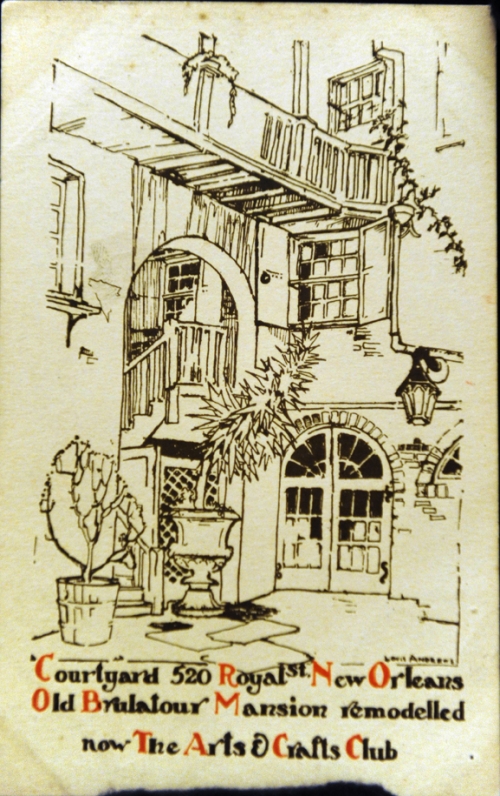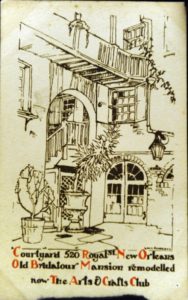Arts and Crafts Club of New Orleans
Between 1922 and 1951, the Arts and Crafts Club of New Orleans worked to enrich and expand the city’s artistic heritage and served as one of its cultural centers.

Courtesy of The Historic New Orleans Collection
Old Brulatour Mansion Courtyard, 520 Royal Street, New Orleans. Unidentified
Between 1922 and 1951, the Arts and Crafts Club of New Orleans worked to enrich and expand the city’s artistic heritage and served as one of its cultural centers. Headquartered in the French Quarter, the club brought a renewed vitality to the area by providing local artists with a place to meet and exhibit their work. In the process, it stimulated the preservation of the French Quarter’s architectural heritage, which was then in serious decline. Seeking to introduce contemporary artistic influences and movements to New Orleans, the club sponsored traveling exhibitions, lectures, and classes for emerging artists.
Club Origins
The early twentieth century New Orleans artistic community was motivated to organize, at least in part, by the loss of three historical buildings in the French Quarter. The Tile Roof Building and the St. Louis Exchange Hotel were demolished in 1917, and the French Opera House, a cultural landmark, burned December 4, 1919. Author Lyle Saxon, who lamented the deterioration of the neighborhood, wrote newspaper articles that depicted the Quarter in a romantic light in order to attract writers and artists to the French Quarter. An ardent preservationist, Saxon also purchased and restored the building at 534–536 Royal Street for his home in 1920. Other artists and writers soon followed him into the Quarter.
Sharing Saxon’s desire to form an artists’ community, painter Alberta Kinsey invited French Quarter artists to meet informally at her apartment. As the group grew, they moved to the Jackson House, located at the corner of Cabildo Alley and St. Peter Street, but soon found that space limited as well. Calling themselves the Artists Guild, the group met for three months in 1919 in the Old Mortgage Building (now known as the American Legion Home), before reorganizing as the Arts and Crafts Club. Beginning in 1921, the group met in the Green Shutter Tearoom at 631–633 Royal Street. Its owner, Martha Gasquet Westfeldt, became a charter member of the club and an officer on its board.
Artists, writers, and musicians—many of whom joined the club—found the French Quarter, with its markets, groceries, pharmacies, bookstores, and hardware stores, a comfortable and charming neighborhood. These new residents gradually transformed the neighborhood into a kind of “Greenwich Village South,” with the Arts and Craft Club at its center. Pianist-composer Genevieve Pitot frequently played for club parties, while students of the Arts and Crafts Club presented an annual costume ball, the highlight of the year’s social events. Artist Louis Andrews Fischer, who owned a bookstore on St. Peter Street, designed Mardi Gras costumes and floats for many years. Other artists associated with the organization include Angela Gregory, Clarence John Laughlin, Eugene Loving, Charles Reinike, and Gideon Townsend Stanton.
Establishment and Development
The Arts and Crafts Club found a home in the Brulatour mansion at 520 Royal Street. Thanks to the generosity of preservationist William Ratcliff Irby, the building was renovated for their use. Architects Favrot and Livaudais remodeled the rear of the building, which featured high ceilings, a long first-floor exhibition room, and well-lit studios on the second and third stories. The club moved into its new home in December of 1921 and was officially incorporated on June 2, 1922, with painter Charles Bein serving as its first director.
For most of its existence, the Arts and Crafts Club received financial support from Irby, George and Martha Westfeldt, Sarah Henderson, and her brother, Hunt Henderson. After Irby’s death in 1926, financial support fell primarily to the Hendersons. As a result, the club moved again, this time into a building at 712 Royal Street, owned by Sarah Henderson. It was there that the members of the organization fulfilled many of their goals. In 1932, Paul Ninas assumed the position of director when Charles Bein resigned.
New Orleans School of Art
Shortly after the club’s incorporation, it began offering classes to aspiring young artists. The New Orleans School of Art faculty included Ninas, Albert Rieker, Weeks Hall, William Spratling, Clarence Millet, Julius Woeltz, Will Henry Stevens, Caroline Wogan Durieux, and Enrique Alférez, among others. Members of the Newcomb College School of Art, including Gertrude Roberts Smith, Amelie Roman, and Lota Lee Troy, served as club instructors and board members. At the time, the New Orleans School of Art was the only organization, not affiliated with a university or college, providing arts education in the South.
Course offerings included painting, drawing, composition, sculpture, ceramics, and architecture. Students received instruction in the basics of composition, technique, and craftsmanship before exploring nontraditional art movements. Architecture classes were based on the teaching methods of the École Nationale des Beaux-Arts in Paris, which emphasized classical art and architectural form. Children’s classes provided a foundation for students like painter Boyd Cruise, who began his art studies with Marjorie Callender. Other students included Josephine Crawford, Edmund John “Jack” Sparling, Juanita Gonzales, Mirielle Caboche, Mary Basso, and John McCrady. Basso and McCrady married and eventually opened their own art school in the French Quarter.
Exhibits
During its heyday, the club introduced modern art to New Orleans through its instruction, exhibitions, lectures, and other programs. Addressing global trends in art, the club invited modernist author Gertrude Stein to speak. International artists whose work was exhibited included Raoul Dufy, Joan Miró, Diego Rivera, Frieda Kahlo, Paul Cézanne, August Renoir, Pablo Picasso, Wassily Kandinsky, Henri de Toulouse-Lautrec, Edgar Degas, Camille Pissarro, Henri Matisse, Salvador Dali, Auguste Rodin, Edouard Manet, and Paul Gauguin.
Among the nationally recognized American artists whose work was exhibited were Edward Hopper, Thomas Hart Benton, J. M. Whistler, Maurice Prendergast, Rockwell Kent, George Biddle, Peggy Bacon, and Adolf Dehn. In addition, the club was the first in the city to exhibit the work of Georg Jensen, a prominent Danish silversmith, as well as Orrefors Glass from Sweden and Steuben Glass from New York.
Final Days
Despite the economic strains of the Great Depression, the club survived into the mid-twentieth century. John F. Clemmer, who had been both a student and a faculty member of the club, became its director in 1948. Following the death of Sarah Henderson in 1950, the building at 712 Royal Street was sold and the club closed its school of art. Under the name Arts and Crafts Gallery, the club moved downriver to the Miltenberger House at 900 Royal Street, but financial difficulties continued to plague the organization.
On March 24, 1951, after thirty years in operation, the Arts and Crafts Club closed its doors permanently. Its members could be proud of the group’s cultural achievements, however. In a relatively short period of time, they helped redefine and restore the city’s French Quarter and educate a generation of artists. Though sometimes met with skepticism, the club also introduced new ideas about art, and the work of innovative artists, to a traditionally conservative artistic community.
